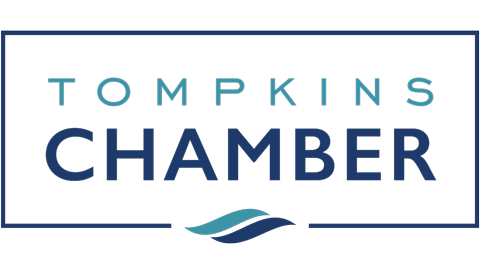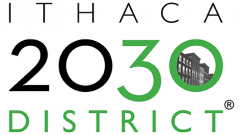By Peter Bardaglio
Executive Director
Ithaca 2030 District
Adapted from an article by Peter Bardaglio that ran in Tompkins Weekly on August 15th, 2016
Earlier this summer 17 local building owners, community partners, and professional stakeholders came together to launch the Ithaca 2030 District. In doing so, Ithaca joined the ranks of 12 other forward-thinking cities in the United States and Canada that are working toward the goal of cleaner and greener commercial buildings.
2030 Districts, initiated by the non-profit research organization Architecture 2030, are unique private and public partnerships bringing together property owners and managers to meet the energy and resource reduction targets of the 2030 Challenge for Planning. Through collaboration, leveraged financing, and shared resources, they benchmark, develop and implement creative strategies, and establish best practices and verification methods for measuring progress towards a common goal.
Thanks to the outstanding work of Sustainable Tompkins, EcoVillage at Ithaca, Local First Ithaca, our local governments, and many other organizations, Ithaca and Tompkins County have long been leaders in sustainability and climate action. The establishment of the Ithaca 2030 District, building on these efforts, places our community in the vanguard of a movement of private sector pioneers coming together to reduce energy use, water use, and transportation emissions. Ithaca joins Albuquerque, Cleveland, Dallas, Denver, Grand Rapids, Los Angeles, Pittsburgh, San Antonio, San Francisco, Seattle, Stamford, and Toronto as part of the 2030 Districts Network.
It is a well-known fact that the built environment – commercial and municipal office buildings as well as multi-family housing – is a large consumer of natural resources and generator of emissions. Indeed, 75 percent of all the electricity produced in the United States is used just to operate buildings, and the building sector is responsible for 45 percent of the nation’s CO2 emissions.
What are the goals of 2030?
The newly established Ithaca 2030 District will further strengthen our commitment to combat the effects of climate change and, at the same time, spur innovation in our downtown. The recently-implemented Energize NY Finance program, which offers financing for energy efficiency and renewable energy projects in commercially-owned buildings, will help facilitate the building upgrades necessary to meet the goals of the 2030 District movement.
These include the following:
- Existing Buildings and Infrastructure Operations
- 50% reductions in energy use, water consumption, and transportation emissions by 2030.
- Energy Use: A minimum 10% reduction below the national average by 2015, with incremental targets reaching a 50% reduction by 2030.
- Water Use: A minimum 10% reduction below the District average by 2015, with incremental targets reaching a 50% reduction by 2030.
- Transportation CO2 Emissions: A minimum 10% reduction below the District average by 2015, with incremental targets reaching a 50% reduction by 2030.
- New Buildings, Major Renovations and New Infrastructure
- Immediate 50% reductions in water consumption and transportation emissions, with energy use in the design year reaching carbon neutrality by 2030.
- Energy Use: An immediate 70% reduction below the national average, with incremental targets reaching carbon neutral by 2030.
- Water Use: An immediate 50% reduction below the District average.
- Transportation CO2 Emissions: An immediate 50% reduction below the District average.
- Property owners and managers are voluntarily committing their properties to Ithaca 2030 District goals; they are not required to achieve the District goals through legislative mandates or as individuals.
Why Ithaca?
The Ithaca 2030 District got its initial impetus from a 2013 visit by Ed Mazria, the founder and CEO of Architecture 2030, which issued the 2030 Challenge. Mr. Mazria was the keynote speaker at HOLT’s 50th anniversary celebration and he met with the members of the Tompkins County Climate Protection Initiative (TCCPI) while he was in town. TCCPI and HOLT began soon after to explore the potential of a 2030 District in Ithaca. With the support of its coalition members, establishing a 2030 District in Ithaca became an official project of TCCPI in 2014.
The Park Foundation and the New York State Energy Research and Development Authority (NYSERDA), through the Cleaner, Greener Communities program, have provided support to plan and begin building the Ithaca 2030 District. In addition, Cornell Cooperative Extension-Tompkins County, HOLT Architects, and Taitem Engineering have contributed significant in-kind gifts in the form of pro bono services.
Besides promoting crucial climate protection measures, the Ithaca 2030 District seeks to demonstrate that healthy and high performing buildings make good financial sense. District members will do this by bringing together diverse stakeholders, leveraging existing and developing new incentives and financing mechanisms, and creating and sharing joint resources. They will develop realistic, measurable, and innovative strategies to assist district property owners, managers, and tenants in meeting aggressive goals that keep properties and businesses competitive while operating buildings more efficiently, reducing costs, and reducing the environmental impacts of facility construction, operation, and maintenance.
These collaborative efforts will establish the Ithaca 2030 District as an example of a financially viable, sustainability focused, multi-sector driven effort that maximizes profitability and prosperity for all involved. The District builds on the TCCPI model to provide a non-competitive environment where building owners, community organizations, and professionals come together to share best practices and accelerate market transformation in Ithaca’s built environment.

